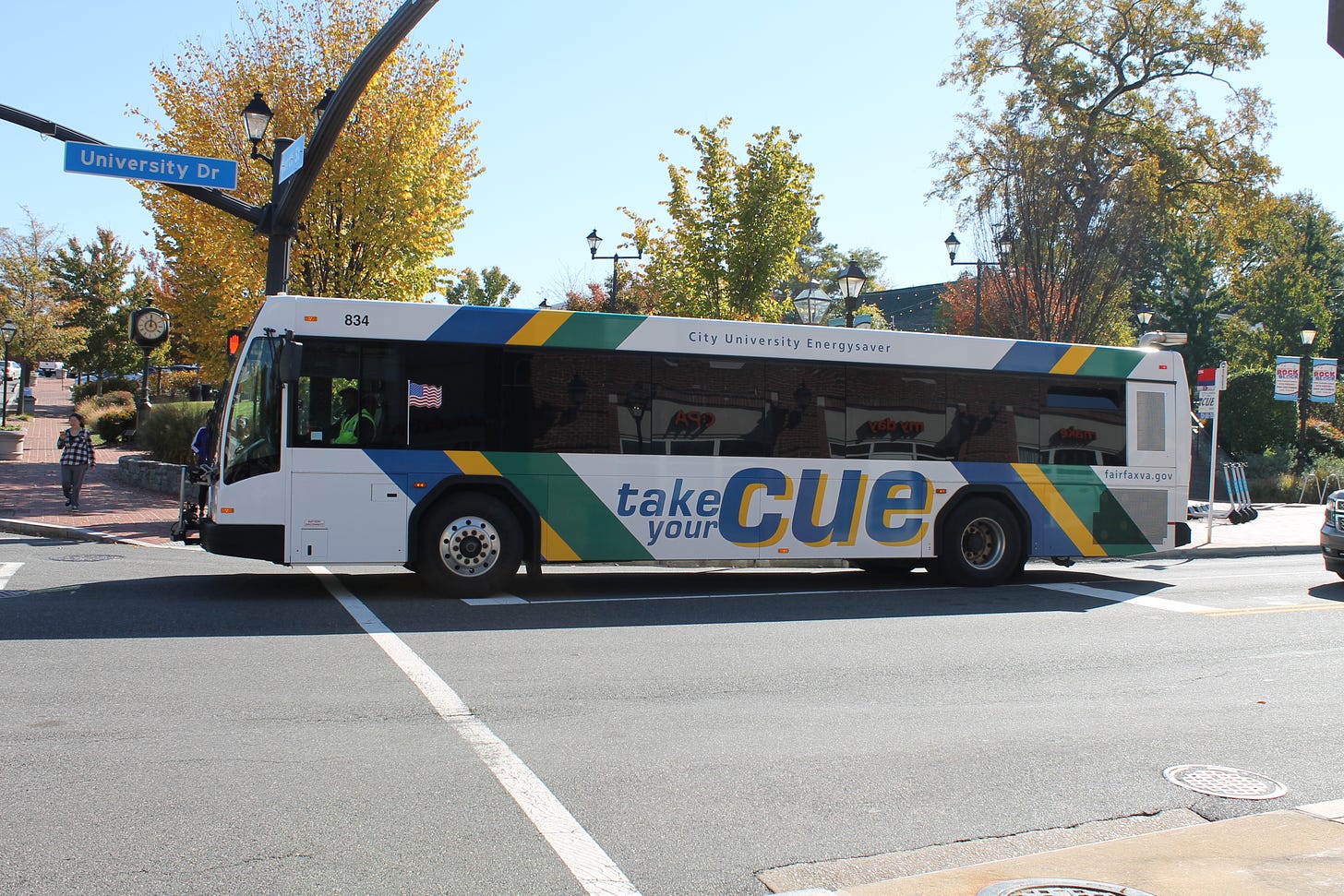City of Fairfax Free CUE Bus Service Generating Growth
CUE is on Pace to Hit 700,000 trips for FY2023. Service Helps Reduce Traffic, Greenhouse Gas Emissions
Fairfax City residents have been riding CUE Bus for more than 40 years and are familiar with the free bus service. However, there are many Northern Virginians who visit the city to shop, eat, and work, or to attend George Mason University. For anyone who is unaware of the benefits of the city’s free public transit, here’s what’s new with CUE.
Riding CUE Bus is an easy way to help reduce traffic, greenhouse gas emissions, accidents, and money spent on fuel and vehicle maintenance. With 200 stops in the city, CUE is a convenient way to connect to local destinations. Connecting to regional destinations is easy, too, with stops at the Vienna/Fairfax-GMU Metrorail Station and stops shared with other bus services like Metrobus, Fairfax Connector, and the Mason shuttle.
Zero-Fare Pilot Program
During the height of the pandemic, when everyone was advised to stay home, CUE continued to provide 500 trips a day. “That told us there’s a core group of people in the city who have no alternative to public transit,” said Ryan Visci, transit manager. “So being able to provide bus service to them is really impactful.”
A bus trip before COVID cost $1.75. That adds up to more than $1,000 a year in transportation costs for frequent riders. At its Jan. 25, 2022, meeting, Fairfax City Council endorsed a four-year pilot program to provide free rides. “Fare free means everyone has equitable access to transportation, access to opportunities for work, or just to live their lives, run errands, and make it to medical appointments,” said Visci.
A study completed in the fall of 2021 found removing bus fares would increase ridership, improve operating efficiency, and improve access to state funding. Anyone who has avoided riding CUE because they didn’t know how the fares worked can now just hop on the bus without worry.
New Routes and Growing Ridership
Before the pandemic disrupted transit plans around the globe, CUE was providing 2,500 trips a day. It has taken a while to reach fall 2019 numbers, but CUE did so last spring. By last fall, ridership had rebounded and grown to 120-130% of 2019 ridership numbers.
CUE recently updated a route to provide better service to residents of the Layton Hall Drive Apartments and the new Flats on University student housing development. Taken together, the two bus stops are the fourth busiest in the system. “A lot of new residents in the city are using CUE to get to Mason, and it’s taking a lot of stress off our roads,” said Visci. Additionally, bus riders reduce single occupant vehicles and their emissions.
CUE rolled out six new buses last year, with modernized interiors, new seating that is more comfortable and resilient, non-slip flooring, and yellow powder-coated handlebars that are easier to see for people with visual impairments. More exterior lighting was added to make it easier for people to see when boarding.
Installing shelters at bus stops will make riding CUE more appealing for riders who are considering taking the bus. Of the 200 bus stops in the system, 40-45 have shelters. “We are using grant money from the Northern Virginia Transportation Commission through the I-66 Commuter Choice program to install more shelters,” Visci said. “We’re doing fieldwork to decide where those bus shelters will be placed. It’s kind of a puzzle between the physical space we have and requirements for things like easements and right-of-way. We’re trying to install as many shelters as we can with that money, probably between five and ten new shelters in addition to the three new shelters serving the updated route.”
CUE by the Numbers
CUE provided 536,110 trips in fiscal year 2022
CUE is on pace to hit 700,000 trips for FY2023
CUE provided 82,776 trips in September 2022, the highest ridership of any month since 2013
Buses will have a new look soon. A branding study was conducted last year with input from the community. CUE will soon roll out buses with new colors, a new logo, and new signs at stops.
The best place to learn more about CUE is online at cuebus.org, where the TransLoc app is available to download on smartphones. You can use your location to find where you are, and TransLoc will tell you the best route to take and when to wait for the bus. The app gives you real-time information about when the next bus is arriving. Printed schedules are available throughout the city and online.
“I’m really excited about where CUE is going in the future. CUE has been a great asset for the city for more than 40 years, and I’m really excited for more people to try riding with us,” said Visci.
Hop On!
CUE service is available 5:15 a.m. to 11 p.m. Monday-Friday; 8 a.m. to 9 p.m. Saturday; and 9:30 a.m. to 6:30 p.m. Sunday. (No bus service on New Year’s Day, Independence Day, Thanksgiving, and Christmas).
About the Northern Virginia Regional Commission
NVRC is a consortium of thirteen local governments representing more than 2.5 million residents. The region has a GDP of $250 Billion which is 41.4% of the GDP of the Commonwealth of Virginia. Northern Virginia’s GDP is larger than 23 states and the District of Columbia and if a country would be the 49th largest economy in the world.




